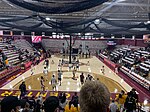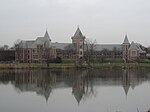Mazzella Field
1989 establishments in New York (state)American football venues in New York (state)College football venuesCollege lacrosse venues in the United StatesCollege soccer venues in the United States ... and 13 more
Defunct college football venuesIona Gaels footballIona Gaels men's soccerIona Gaels women's soccerLacrosse venues in New York (state)Multi-purpose stadiums in the United StatesNew York (state) sports venue stubsRugby New York stadiumsRugby union stadiums in New York (state)Soccer venues in the New York metropolitan areaSports in New Rochelle, New YorkSports venues completed in 1989Sports venues in Westchester County, New York

Mazzella Field is a 2,400 seat soccer-specific stadium on the campus of Iona College in New Rochelle, New York. It is home to the Iona College Gaels soccer, rugby, and lacrosse teams, as well as the Women's New York Magic of United Women's Soccer.First opened in 1989, it was originally used as a multi-purpose stadium that also hosted the school's football team until the program was disbanded in 2008.The field was the site of the 2008 Empire State Games men's lacrosse championships. In June 2017, Mazzella Field received a new FieldTurf surface striped for soccer and lacrosse.
Excerpt from the Wikipedia article Mazzella Field (License: CC BY-SA 3.0, Authors, Images).Mazzella Field
Montgomery Place,
Geographical coordinates (GPS) Address Nearby Places Show on map
Geographical coordinates (GPS)
| Latitude | Longitude |
|---|---|
| N 40.926944444444 ° | E -73.785555555556 ° |
Address
Political Science House
Montgomery Place 53
10804
New York, United States
Open on Google Maps




